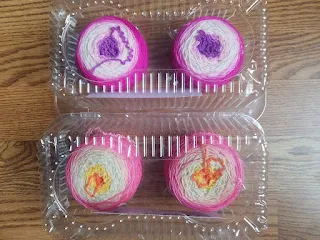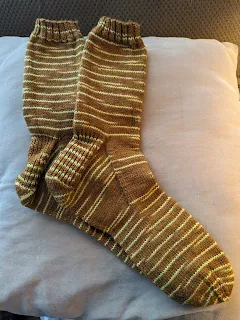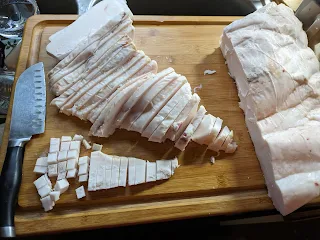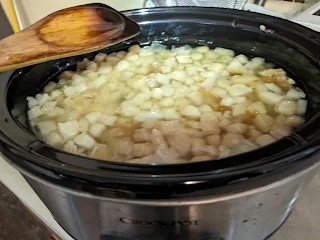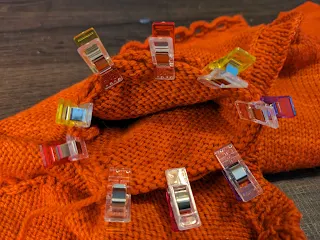I am really excited about March's draw for the Solo Sock Club. I was SO excited that I cast on and knit for quite a while before it occurred to me to take a picture of the yarn to post on the blog. Facepalm.
This is how the yarn looked before I lost control and cast on. The bottom set is closest to these colors.
The yarn is Bashful Gradient Dyed Cupcakes, which was previously sold under Bashful Bags and Fibers. I followed a link to their etsy page, but it doesn't appear that they still have any active listings. If you really want to get your hands on some, you might get lucky and find a stashed set on ravelry with which someone would be willing to part.
For this yarn, I really want to use up every little bit of that scrumptious color. I've opted for a toe-up pattern, Laxo Socks.
Using a toe-up pattern means that I can keep knitting until all the yarn is used up, ensuring I get all of that lovely color worked into my project. I can't wait to see how these ones turn out. Since I already have a head-start on March, I will likely have these finished well before the month ends.
A wicked good blog about homestead happenings in the shadow of Mount Katahdin, Maine. Many ramblings are sure to happen here, including, but not limited to, knitting, sewing, chickens, gardening, canning, freeze drying, general homestead wanna-be stuff (you can be a homesteader with just chickens, right?!?), and any other activities that manage to capture my short little attention span at the time.
Search World On A String Designs
Wednesday, March 6, 2024
Monday, March 4, 2024
February Solo Sock Club
It turns out February kept me quite busy at my day job. Since only about 2 people read this blog, day job won out over blog posts. I did, however, finish my February socks a while back. The yarn I pulled for February was a self-striping yarn in an American flag pattern.
The yarn is from Artistic Yarn by Abi. Truth be told, this one has been in stash for a loooooooong time. I don't think she sells this pattern any longer; she may have changed her business name since I bought this yarn. That's one of the features of the Solo Sock Club, though - I get to use up amazing yarns that have been languishing in storage so long that I forgot I even owned them.
Because this is a self-striping yarn, I opted for a vanilla pattern to let the colors shine on this pair. I am very pleased that this yarn was pulled early in the year...recall that I didn't label the bags and I'm choosing them at random. I'm glad I will have the flag socks ready to go for Memorial Day and the 4th of July. I mean, I won't hesitate to wear them any time of year, but it's nice to have themed socks available when a holiday rolls around.
Stay tuned to see the March sock club yarn and pattern.
Saturday, March 2, 2024
February Solo Sock Club Yarn and Pattern
It's March! I know what you're thinking, but I didn't skip February in the sock club. I simply didn't post about it (I know).
The January socks turned out great. Here's the yarn for the February socks:
Due to the self-striping nature of the sock yarn, these will be knit up in a vanilla sock pattern so that it doesn't look too busy with all the color changes.
Stay tuned to see the finished socks!
Monday, February 5, 2024
January Solo Sock Club
I'm still enjoying the self-curated Solo Sock Club, inspired by the Yarn Harlot. I made good progress. Here are my finished January socks:
The yarn is one I dyed myself, I called the colorway Caramel Apple from World on a String Designs. The base is 75% superwash merino and 25% nylon. I dyed it in a way that would prevent color pooling around the heel area. This used a vanilla sock pattern. January is in the books; I'll post about February soon.
Saturday, January 6, 2024
Solo Sock Club
We are 6 days into 2024. On New Year's Day, I noticed this Instagram Post by the Yarn Harlot. She pulled 12 skeins of sock yarn from her stash and paired each one with an appropriate pattern, bagged them up and BOOM - she calls it her Self-Imposed Sock Club. This is such a GENIUS idea, and I cannot believe my luck that I saw it on the very first day of the year. I went to the basement, retrieved 12 forgotten favorites of sock yarn and then proceeded to my Ravelry favorites section and matched them up with patterns. I bagged mine up and put them under the Christmas tree.
In lieu of a subscription that will come once a month, I will simply grab a bag and get to work. Bonus, this idea also helps work down my stash of yarn that I already have, and it's budget friendly, too. I've collected all the bags on a wooden tray. My brother and sister-in-law sent us a Harry & David gift box for Christmas, and along with the goodies came this lovely little tray. I thought it would make the perfect spot to keep my makeshift sock club. Eventually, we will put the Christmas tree away, and I feel as though the tray is a place that provides a bit of organization to the project - and if it is determined to be "in the way" at a future point, the tray can be easily moved to a new home.
When I saw the original post and decided I wanted to do this also, I was mid-project on a pair of socks. I was determined to finish them ASAP so that I could dig into the first bag of my 2024 Sock Club. Never had a project FELT like it took so long. I did complete them yesterday, and immediately asked my husband to choose a bag for me. He graciously obliged, and I opened it to find this: This is a skein of yarn that was hand dyed by me and was originally dyed for my Etsy shop. It never did sell, but it was always a favorite of mine, so I pulled it for my sock club. This is the only skein out of the year that I dyed myself. It is a blend of 75% superwash merino and 25% nylon. The colorway is called Caramel Apple. It works up with short bursts of mini stripes in the contrast color. I'm nearly ready to turn the heel on the first sock. Due to the way that the colors in the yarn will work up, I opted for a vanilla sock pattern in this case. I find that in knitting projects, either the colors or the textures will pop. For yarn with lots of colors, a simple pattern will show them off. For a pattern with oodles of texture, a solid and light-colored yarn will really show off those pattern details. I am using a plain pattern here to allow the dye job to really shine in my finished socks. I will post the finished socks once they are finished. Follow along, as I will have updates on all of the monthly sock knits.
When I saw the original post and decided I wanted to do this also, I was mid-project on a pair of socks. I was determined to finish them ASAP so that I could dig into the first bag of my 2024 Sock Club. Never had a project FELT like it took so long. I did complete them yesterday, and immediately asked my husband to choose a bag for me. He graciously obliged, and I opened it to find this: This is a skein of yarn that was hand dyed by me and was originally dyed for my Etsy shop. It never did sell, but it was always a favorite of mine, so I pulled it for my sock club. This is the only skein out of the year that I dyed myself. It is a blend of 75% superwash merino and 25% nylon. The colorway is called Caramel Apple. It works up with short bursts of mini stripes in the contrast color. I'm nearly ready to turn the heel on the first sock. Due to the way that the colors in the yarn will work up, I opted for a vanilla sock pattern in this case. I find that in knitting projects, either the colors or the textures will pop. For yarn with lots of colors, a simple pattern will show them off. For a pattern with oodles of texture, a solid and light-colored yarn will really show off those pattern details. I am using a plain pattern here to allow the dye job to really shine in my finished socks. I will post the finished socks once they are finished. Follow along, as I will have updates on all of the monthly sock knits.
Labels:
2024 Spontaneous Sock Club,
January 2024 Sock Club,
sock club,
sock knitting,
sock knitting pattern,
sock yarn,
sock yarn subscription,
stash yarn,
world on a string designs,
Yarn Harlot
Location:
Maine, USA
Thursday, December 28, 2023
How to Render Lard
Nearly all the meat our family consumes is grown within a mile of our home. We raise and process our own meat chickens. We also buy a pig and a half a cow from our neighbors, who raise them. One of the perks of this is that I request the pig fat when the animals are processed, so I can render it into lard. Home-rendered lard is a fabulous thing to have on hand. The best of the lard is great for baking - it results in flaky pie crusts, with a mild (and not porky) flavor. While lard gets a bad rep, it is really the shelf-stable lard from the grocery store (which is shelf stable because it has been hydrogenated) that is the real villian. Home-rendered lard has not gone through that process, and doesn't have the same unhealthy characteristics - the shelf stable version contains trans fats, whereas the home-rendered version does not. Shelf stability is a great feature on an industrialized scale, as it reduces waste and cost. However, on our small homestead, we simply store the unrendered fat in the freezer, and the rendered lard in the fridge until we are ready to use it. Problem solved! The result is delicious lard for our family without the health risks of hydrogenated fats.
We use lard a lot for frying eggs or meat, or for anything we want to make crispy. I often make freezer batches of breakfast burritos, and when put in the microwave, the tortillas get soft and sometimes soggy. I heat them in the microwave, then finish them off on the stove in a bit of rendered lard. They crisp right up and taste amazing. Lard is also great for frying pretty much anything and gives delightfully crispy results. So *how* does one home render lard, you ask? Great question; I'd love to tell you. Our pig fat comes from the butcher in a large, several-pound package, vacuum sealed like our meat. I use a crock pot to melt it down, and the first step is cutting up the fat. I start with the fat frozen solid. It takes a bit of elbow grease to get through the thicker parts, but as the fat warms it will start to melt on hands and can make the process quite slippery. I start by cutting the fat down into big strips that are no wider than my knife is long. Then, I cut off slices about 1/4 to 1/2-inch thick. Next, I cube these down, then add them to my crock pot over low heat. The smaller the chunks, the faster the lard will render. You certainly want them to be chunks of 1" or less. I aim for 1/2 to 1/4-inch chunks, and this is often led by how much available time I have to dice it up - on a busy morning, the pieces are larger. If your butcher will grind it for you, or if you have a grinder, such as this KitchenAid attachment, then it will significantly cut down on processing time. I have the KitchenAid attachment, but I normally just cut it up with a knife, as I don't want to bother cleaning fat out of the grinder attachment and typically I don't mind if it sits in the crock pot a few hours longer. As the fat heats, it will gradually melt. I come back every couple of hours, and when there is enough liquid, I simply scoop some off the top and store in a Mason jar. I do filter my lard, and I do this with a funnel and cheesecloth. As you can see, the liquid fat is an off-white color and semi-transparent. As it cools, however, it will harden into a snow-white solid in the jar. I highly recommend givnig this a try. Your home-rendered lard can serve a replacement for anything you'd use lard or Crisco to prepare in your kitchen, and it does it without unhealthy trans fats. You will gain more control and confidence about what you are consuming, where it came from, and how the animals were treated. If you don't have access to your own pig fat, you may be able to obtain some from your local butcher - it's worth an ask. Leaf fat is the prime material for this job; it is the fat around the kidneys of a pig. This was prepared with back fat, which contains more meaty bits. I find that the first draw of liquid from the back fat is completely suitable for pastry baking, and it has an odorless product. The closer you get to the end of the render, there may be more color and potentially a bit of a piggy flavor...sort of like bacon. This is great for frying eggs, making biscuits, or any savory type of cooking. Just save your first draw and label it well for pastries and sweets.
We use lard a lot for frying eggs or meat, or for anything we want to make crispy. I often make freezer batches of breakfast burritos, and when put in the microwave, the tortillas get soft and sometimes soggy. I heat them in the microwave, then finish them off on the stove in a bit of rendered lard. They crisp right up and taste amazing. Lard is also great for frying pretty much anything and gives delightfully crispy results. So *how* does one home render lard, you ask? Great question; I'd love to tell you. Our pig fat comes from the butcher in a large, several-pound package, vacuum sealed like our meat. I use a crock pot to melt it down, and the first step is cutting up the fat. I start with the fat frozen solid. It takes a bit of elbow grease to get through the thicker parts, but as the fat warms it will start to melt on hands and can make the process quite slippery. I start by cutting the fat down into big strips that are no wider than my knife is long. Then, I cut off slices about 1/4 to 1/2-inch thick. Next, I cube these down, then add them to my crock pot over low heat. The smaller the chunks, the faster the lard will render. You certainly want them to be chunks of 1" or less. I aim for 1/2 to 1/4-inch chunks, and this is often led by how much available time I have to dice it up - on a busy morning, the pieces are larger. If your butcher will grind it for you, or if you have a grinder, such as this KitchenAid attachment, then it will significantly cut down on processing time. I have the KitchenAid attachment, but I normally just cut it up with a knife, as I don't want to bother cleaning fat out of the grinder attachment and typically I don't mind if it sits in the crock pot a few hours longer. As the fat heats, it will gradually melt. I come back every couple of hours, and when there is enough liquid, I simply scoop some off the top and store in a Mason jar. I do filter my lard, and I do this with a funnel and cheesecloth. As you can see, the liquid fat is an off-white color and semi-transparent. As it cools, however, it will harden into a snow-white solid in the jar. I highly recommend givnig this a try. Your home-rendered lard can serve a replacement for anything you'd use lard or Crisco to prepare in your kitchen, and it does it without unhealthy trans fats. You will gain more control and confidence about what you are consuming, where it came from, and how the animals were treated. If you don't have access to your own pig fat, you may be able to obtain some from your local butcher - it's worth an ask. Leaf fat is the prime material for this job; it is the fat around the kidneys of a pig. This was prepared with back fat, which contains more meaty bits. I find that the first draw of liquid from the back fat is completely suitable for pastry baking, and it has an odorless product. The closer you get to the end of the render, there may be more color and potentially a bit of a piggy flavor...sort of like bacon. This is great for frying eggs, making biscuits, or any savory type of cooking. Just save your first draw and label it well for pastries and sweets.
Labels:
baking,
crock pot,
home-rendered lard,
homesteading,
lard,
rendering lard,
self-sufficiency
Location:
Maine, USA
Thursday, December 7, 2023
Wee Wildflower Gifts and Easing in Sleeves in Seamed Knitting
I have a new project (technically two) hot off the needles. Anytime someone I know has a new bundle of joy, I feel an ovewhelming urge to knit something tiny to welcome the little one to the big world. In this particular case, the arrival of said baby also meant a promotion to Big Sister for an older sibling. As a huge fan of the Coastal Knits book and also the miniature versions in Coastal Kids, the Wee Wildflower pattern has been in my queue for quite some time. It's such an adorable piece, and it has POCKETS.
This seemed like the perfect time to whip one of these up. In the case of the big sister....well, that's a big deal. Clearly, only two sweaters would do (matching, of course). I was thrilled to find a suitable yarn in my stash that had enough yardage to complete both sweaters, an indie-dyed polwarth and silk blend. Now, you may have heard of Second Sock Syndrome. This is where you finish one sock, and the other feels like an absolute slog, and it takes you forever to complete it. I feel as though this affliction is even more serious when it manifests as Second Sweater Syndrome. Therefore, I always reccomend that if you are knitting two of anything and those things are not the same size, ALWAYS DO THE LARGER ITEM FIRST. This makes the progession of the smaller item feel as though it is going faster than the first (as it should), and if you struggle to maintain project focus, the additional motivation in this approach is critical.
One of the features of the Wee Wildflower patern is that it is knit flat and seamed. I expect this may scare off a few knitters, but I promise it's not as hard as it seems (see what i did there?). There are some advantages to seamed knitting, one of which is that seams in knitted garment add structure and support the stitching. Where it *can* get a little tricky is sewing sleeves into sleeve holes, especially when the 2 circumferences do not match up perfectly. The first time I did this, I had not distributed the stitches very well. It was a disaster, and I ended up taking it apart. There is a much better way, and I would like to share my preferred method.
I start by marking the midpoint on the sleeve, and identifying the top and bottom points in the armhole. Then I loosely put the sleeve in the armhole. Next, I line up the midpoint of the sleeve with the top of the armhole, and the ends with the bottom of the armhole, and then I secure these points with sewing clips. Next, I work my way around the armhole, stretching and securing the sleeve so that it is eased in to the full space of the armhole and is also evenly distriubted throughout. During this process, I will stretch, inspect, shift and secure until I am satisfied that the sleeve is properly positioned and stretched evenly all the way around. At this point, I secure a piece of yarn and sew the sleeve in place using the mattress stitch and removing clips as I go around. I have always been pleased with the results when doing it this way, and I haven't had to pull it out and start over, like I did before I started using this technique. The sweaters are complete now and have been gifted. I hope the recipients enjoy the sweaters as much as I enjoyed crafting them. Next up on the needles are a few Christmas presents...stay tuned!
I start by marking the midpoint on the sleeve, and identifying the top and bottom points in the armhole. Then I loosely put the sleeve in the armhole. Next, I line up the midpoint of the sleeve with the top of the armhole, and the ends with the bottom of the armhole, and then I secure these points with sewing clips. Next, I work my way around the armhole, stretching and securing the sleeve so that it is eased in to the full space of the armhole and is also evenly distriubted throughout. During this process, I will stretch, inspect, shift and secure until I am satisfied that the sleeve is properly positioned and stretched evenly all the way around. At this point, I secure a piece of yarn and sew the sleeve in place using the mattress stitch and removing clips as I go around. I have always been pleased with the results when doing it this way, and I haven't had to pull it out and start over, like I did before I started using this technique. The sweaters are complete now and have been gifted. I hope the recipients enjoy the sweaters as much as I enjoyed crafting them. Next up on the needles are a few Christmas presents...stay tuned!
Subscribe to:
Comments (Atom)
